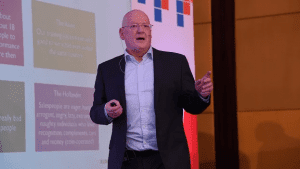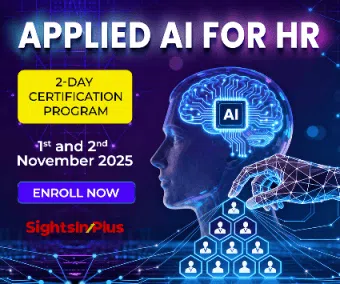In an exclusive Interaction, we are benefited to have Dr. Max Blumberg– Founder-Blumberg Partnership, Visiting Professor, Leeds University Business School, Visiting Researcher, Goldsmiths and University of London.
Max Blumberg, Ph.D., bridges the worlds of business performance and analytics to improve strategy execution, design powerful people processes and increase sales force effectiveness.
Dr. Max has deep experience and success with virtually every aspect of business design, performance, diagnosis, and execution. He first worked as a management consultant at Accenture. He next launched and successfully sold a large technology component distribution company.
In the following chapter of his career he was new business director for two technology companies including IBM SPSS, simultaneously earning his Ph.D. in psychology at Goldsmiths College, University of London. While in graduate school he also launched the Blumberg Partnership, a Top 50 analytics consultancy which delivers analytics and machine learning solutions to organizations like Nestle, Lloyds Register, Hilton Hotels & Resorts, GB Group plc, Angle Technology, the BBC, Rentokil Initial, Barclays Corporate, Brit Insurance, the MOD, the CIPD, and Friends Provident.
In addition to his consulting and research, Max is a psychology commentator for various media outlets, contributes to Achievers Extraordinary (a charity empowering people to help themselves), is a personal fitness and Pilates trainer, and a keen musician (with one successful chart song from his youth). Please see his LinkedIn profile at www.maxb.com for further articles and ideas on people analytics.
Photo credit: people matters
Q: What is People Analytics to you?
People analytics is the use of evidence-based methods to support management decisions about human capital such as investment and talent process activities (recruitment, learning & development, etc). This definition carries a number of implications. First, there is an assumption that people analytics can only use quantitative methods. While quantitative techniques are ideal in corporations with large workforce and sample sizes, it also means that people analytics cannot be conducted with smaller workforces and sample sizes. Hence the reason I prefer the term evidence-based people analytics is because it can include both quantitative and qualitative methods. Second, the definition emphasises people analytics as a tool for supporting management decisions. I mention this because while technologies like visualization and dashboards are useful for monitoring workforce statuses such as absence, headcounts and retention, they are not as effective for guiding human capital decisions. Third, I emphasise that people analytics supports management decision-making rather than replacing it. I mention this because some people argue that management decision-making should be replaced because it contains excessive bias. While it is true that prejudicial bias is a problem, replacing all management decisions with AI would also meaning losing positive management attributes like experience, judgement and intuition. Hence people analytics should support rather than replace management decision-making.
Q-How can organizations use People Analytics to drive business performance?
The key to driving business performance is understanding which competencies drive employee performance, and then ensuring that these competencies are available in the workforce by creating people processes around these competencies. In practice, this means creating:
- Recruitment processes to hire the right competencies
- Learning and development processes to train the right competencies
- Career development and compensation processes to retain the right competencies
People analytics identifies competencies uses a technique called profiling and is perhaps more familiar as the “profiling” technique used by police in TV programs to apprehend criminals! The difference is that people analytics looks for competencies that drive performance rather than characteristics which drive criminal behaviour!
Profiling requires knowledge of psychology, talent management, organizational effectiveness, and predictive statistics. Relatively few companies are current using profiling techniques which is a shame.
In addition to profiling, workforce planning is another important area of people analytics which helps companies to identify how many people and what companies they are likely to require over the next one to three years. Effective workforce planning requires HR professionals to “translate” their company’s corporate strategy into an effective HR strategy. Currently, few companies are yet doing this successfully.
Q- How does People Analytics help employee engagement, retention and more effective workforce?
People analytics systematically identifies organisational factors that drive engagement, retention and workforce performance by integrating and analysing information from multiple sources such as soft data from engagement surveys, and hard data from learning platforms, compensation systems, and performance management platforms. Because people analytics uses data from multiple sources when determining these factors, it tends to reduce the bias associated with using only a few data sources.
In fact, one of the key challenges facing many people analytics functions is the difficulty entailed in integrating multiple data sources. This is not just technological issues, but also semantic difficulties; in other words, ensuring that metrics are defined consistently across the organization. It is not uncommon to find that metrics like performance management, engagement, and even “full time employee” are defined differently across an organization’s regions and business units.Unless an organization can create a taxonomy of common workforce metric definitions, people analytics will not produce meaningful results.
Q- What are current challenges for People Analytics and why do you believe that People Analytics is not delivering on its promised value?
A key challenge for people analytics is its current focus on workforce capability issues like retention and workforce planning instead of emphasising the relationship between workforce capabilities and business outcomes such as revenue, productivity and cost management. Focusing on workforce capabilities at the expense of business outcomes seriously limits the financial value potential of people analytics to organizations. It is also a key reason why many senior executives have not fully embraced people analytics. More importantly, it is also a reason that many organizations are replacing human capital with automation in the form of robotics and chatbots. People analytics needs to demonstrate that people are more valuable than automation, but it is not yet achieving this.
Perhaps one reason for this focus is that HR functions themselves are measured on successful workforce capability outcomes. This needs to change in order for people analytics to realize its true value potential.
Q- HR leaders talking about Design Thinking, how do you see using Design Thinking in People Analytics?
Design thinking is useful for prototyping of products to rapidly determine their viability. In contrast, analytics is all about applied research which is very different from design thinking. For this reason, people analytics does not lend itself to the notion of prototyping because there is no “rapid” way to gather and analyse data.
Design thinking is useful, however, is for testing people processes resulting from people analytics initiatives. For example, once people analytics has identified the competencies required to deliver a particular job role, design thinking can help to rapidly prototype different recruitment processes which use these competencies, and then quickly identifying which prototype process performed best.
Q- Any concluding remarks?
This is an exciting time for people analytics and especially for those seeking to enter the profession, those wishing to consult, and those wishing to build people analytics products. I would encourage anyone wanting to further their people analytics career to consider learning more about business in general, perhaps by doing an MBA, and to consider moving beyond people analytics into business analytics in general. It is there that the real power of analytics lies.



